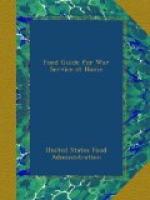All who can should do more than their share—they must do their utmost to make up for those whose circumstances prevent them from doing it. THE INTERESTS AND DESIRES OF EACH OF US IN THIS WAR CAN BE TRANSLATED INTO SERVICE IN NO MORE EFFECTIVE WAY THAN BY CONFORMING OUR FOOD HABITS TO THE NEEDS OF THE HOUR.
FLOUR AND BREAD IN THE ALLIED COUNTRIES
All the Allied countries have been stretching their meagre wheat-supply to the limit and are enforcing the most stringent regulations.
The flour is required to be of high extraction—ordinarily from 81 per cent to 90 per cent, decidedly higher than our 74 per cent. Even with this coarse, gray flour a large percentage of substitute must be mixed, usually 25 per cent. In England there are local regulations on the use of mashed potato in bread. Their bread must be twelve hours old before it is sold, so that people will not be tempted to eat too much. The result is seldom palatable. In France no flour at all may be used to make the delectable pastries and cakes which have long been the delight of the French people and their guests. In Italy, macaroni, which in many regions is as much the “staff of life” as bread, must contain 43 per cent substitute, and in some places may not be manufactured at all.
Both England and France have subsidized bread; the Government has set a price below cost and itself makes up the difference to the baker. England has appropriated $200,000,000 for the purpose.
Bread rations are in force in both France and Italy. France has recently put her whole people on a rigorous ration which limits them to two-thirds of the amount of bread that they have been accustomed to. Remember that bread is a far more important part of the French diet than of ours. Even children under three have bread cards allowing them 31/2 ounces a day. Rations are not a guarantee that the amount mentioned will be forthcoming; they only permit one to have it if it can be obtained. One interesting result of the stringency, according to an American officer writing from Paris, is that guests even at formal dinners, may be asked to bring their own bread, finding this postscript on their invitations: “Apportez un peu de pain si vous le voulez."[1] In Italy the very limited bread rations are fixed locally.
[Footnote 1: “Bring a little bread if you wish it.”]
England has compulsory rations for meat and butter or margarine and sugar, but not for bread. Her bread system is voluntary like ours, but much more detailed. The voluntary ration allows one-half pound of bread a day for sedentary and unoccupied women and larger allowances up to a little over a pound for men doing heavy labor. Waste of any kind is very heavily punished—one woman was fined $500 for throwing away stale bread.




